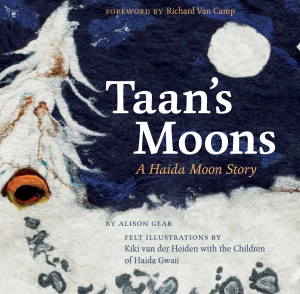 by Alison Gear
by Alison Gear
Based on traditional Haida knowledge, Taan’s Moons is a story/poem of the changing of the seasons, as seen through the eyes of a bear and alongside the traditional Haida moon cycle. Felted illustrations feature many familiar animals following the same cycle.
Strategies/Skills Used
Reading Strategy 1: Access background information.
Reading Strategy 5: Make mental pictures.
Reading Strategy 6: Connect what you read with what you already know.
Reading Strategy 7: Determine the most important ideas and events and the relationship between them.
Reading Strategy 9: Identify and interpret literary elements in different genres.
Reading Strategy 10: Summarize what has been read.
Reading Strategy 11: Make inferences and draw conclusions.
Reading Strategy 12: Reflect and respond.
Writing Skill 6: I choose the tone and point of view that suit my writing purpose.
 TEACHING THE ACTIVITY: PRE-READING
TEACHING THE ACTIVITY: PRE-READING
 (1) View with students the YouTube video “One Year in 40 Seconds.”
(1) View with students the YouTube video “One Year in 40 Seconds.”
(2) Engage students in a group conversation about what they saw in the quick viewing. Watch it again, with the goal of observing and listening for as much information as possible about the cycle of the seasons. Pause at points of seasonal transition to promote additional student observations and thinking. Introduce the last two pages of Seasons by Terri Mack as a scaffold for this ‘freeze-the-frame’ thinking. Encourage listening and building on one another’s ideas.
(3) Recall with students that visibly there are no animals in the video. Have them think of an animal that they hear in the video or that they imagine they could place in this seasonal cycle, and invite small group interaction about that animal’s journey through the seasons. Listen and observe for scientific language of seasonal adaptations of animals.
(4) Initiate a yoga-like break, and teach the “Mountain” and “Tree” yoga poses. Practice for the stillness and silence portrayed in the winter segment of the video. Introduce the “Child’s” yoga pose, and in that pose, have students imagine themselves as an animal sleeping. Wonder with students what this animal might be.
 TEACHING THE ACTIVITY: DURING READING
TEACHING THE ACTIVITY: DURING READING
(5) Introduce Taan’s Moons. Be prepared on the first page of the story to explain the meaning of Taan (“bear” in the Haida language), to explore geographically the location of the Haida Gwaii, and to introduce the drum and the moon. Allow teacher/student collaborative questioning as per Think Aloud/Public Thinking to guide this read-aloud, as you wonder together about the significance of the circular rhythm.
(6) Draw attention to the details in the felted artwork and rich lyrical language, as Taan explores the changing of the seasons. Listen for student inferences of the seasonal principles of hibernation, migration, gathering and harvesting.
(7) In conjunction with reading aloud, introduce students to a framework for thinking from the perspective of a character, per Characterization…Writing in a Role. Invite students to imagine themselves in the character of Taan. On pages 6–9 of the book, under the “Noisy Geese and Migratory Geese Moons,” ask students,“What does Taan observe, hear, feel, and care about?” Document this whole-class perspective on Taan’s thinking to provide an anchor for students’ post-reading activity.
 (8) Maintain a read-aloud process of story, movement break, story, movement break, and introduce the “Downward Facing Dog” yoga pose as a transition pose to practice the flow between previously practiced poses. Bring students together in small groups to practice Tableaux to connect their poses to Taan’s journey. See Sample Taan Yoga Story.
(8) Maintain a read-aloud process of story, movement break, story, movement break, and introduce the “Downward Facing Dog” yoga pose as a transition pose to practice the flow between previously practiced poses. Bring students together in small groups to practice Tableaux to connect their poses to Taan’s journey. See Sample Taan Yoga Story.
 TEACHING THE ACTIVITY: POST-READING
TEACHING THE ACTIVITY: POST-READING
(9) Choose images from the book representing “Food Gathering,” “Fish,” and “Bears Hibernate” cycles of the moon, and invite students to personalize Taan’s experience by giving voice to her thinking through Characterization…Writing in a Role, “What does Taan observe, hear, feel, and care about?” Provide teacher-documented perspective from previously practiced routine as a visual scaffold for this process.
(10) Differentiate for students’ summarization of Taan’s Moons by inviting either a Tableaux presentation of practiced and researched yoga movements, or a Story Cycle using the enlarged 12-piece circular puzzle Graphic Organizer to represent Taan’s journey.
 TEACHING THE ACTIVITY: POST-READING EXTENSION
TEACHING THE ACTIVITY: POST-READING EXTENSION
(11) Introduce Seasons by Terri Mack as another poetic presentation and Aboriginal resource. Invite comparisons and contrasts of style and content between Seasons and Taan’s Moons. Notice similarities and differences in the rhyming lyrical texts and felted wool vs photograph illustrations. Have students observe for seasonal observations, circular motifs, and natural world connections. Introduce a Venn Diagram to facilitate student explanations and understandings.
(12) Introduce additional resources by Terri Mack: We Greet the Four Seasons and We Greet the Four Animals. Provide students with more connections for the circular motif and four quadrants, as mediums for exploring Aboriginal understandings.
(13) Implement the enlarged 12-piece circular puzzle Graphic Organizer for facilitating Story Cycles that can be aligned with many cyclical learning opportunities.